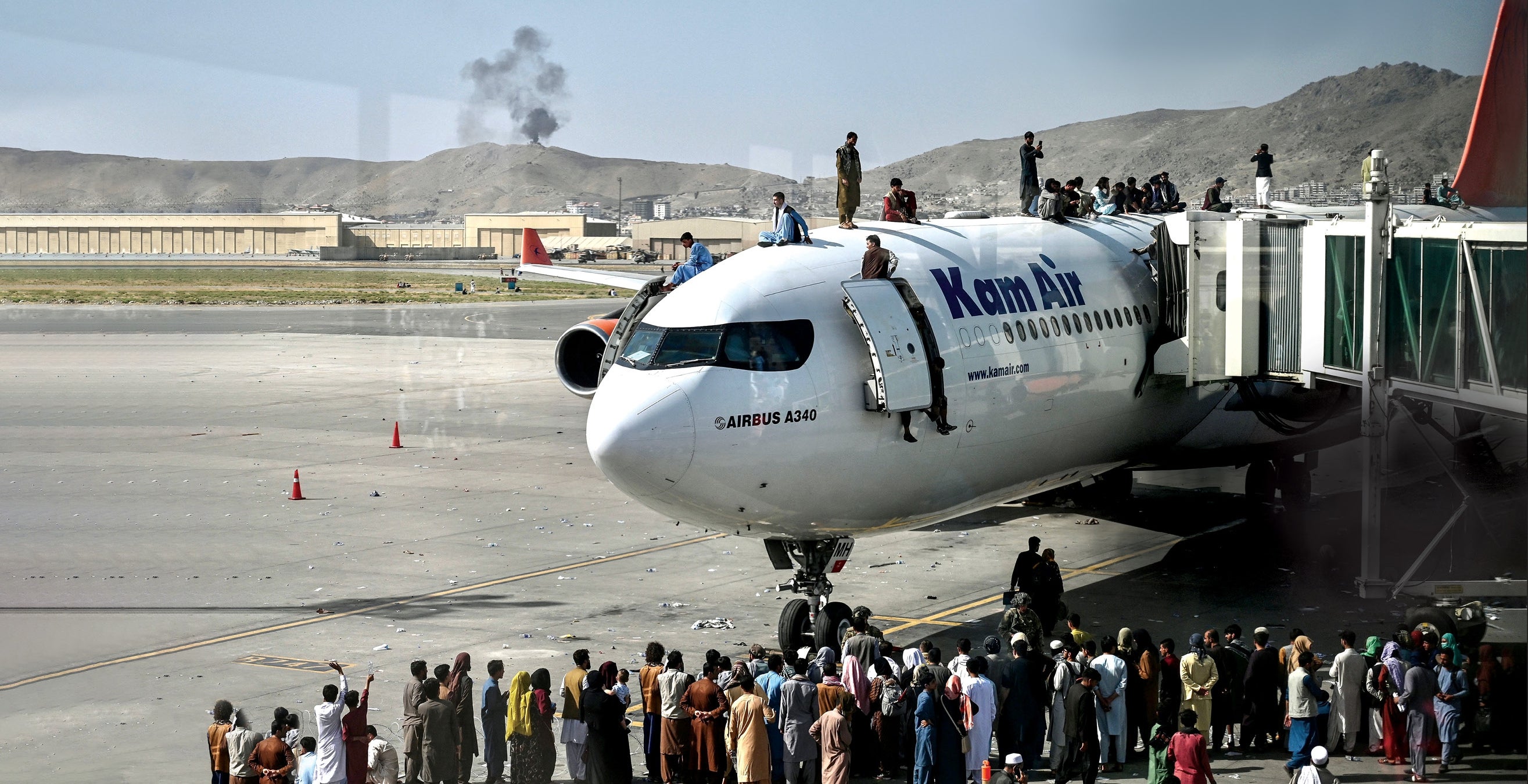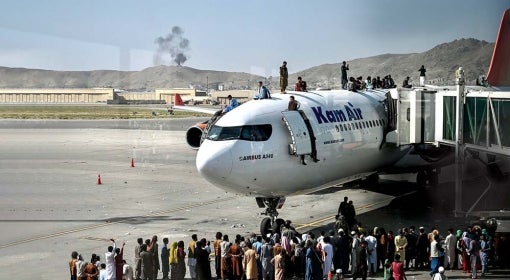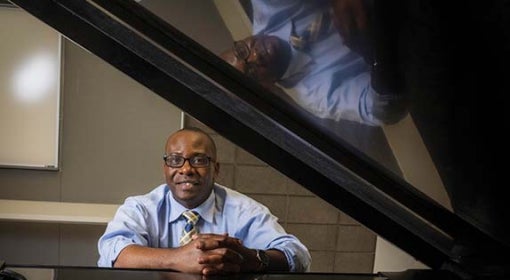A sea of bodies, ever growing, pushes against the concrete wall surrounding Kabul’s Hamid Karzai International Airport. It’s August 2021, and in the days ahead, the mass of people, many dressed in muted-colored tunics or dark hijabs, lift babies and young children above their heads and toward the barbed-wire-topped wall in a desperate bid to get them to safety.
Men, women, children — entire families are caught in a chaotic crush of people who all share the same hope: to escape Afghanistan.
Throughout the summer, as the country’s cities fell one by one to the Taliban, a deluge of Afghans fled their homes. Most converged in Kabul, the country’s capital, knowing it would be the last bastion against the Islamic fundamentalist regime. But on Sunday, Aug. 15, after Taliban fighters entered the city with little resistance, that last bastion shrank to only encompass the interior of the airport’s concrete-bordered perimeter, where about 2,500 U.S. armed forces prepared to evacuate after the United States’ 20-year-occupation.
Almost 7,000 miles away at her family’s home in Pittsburgh’s Squirrel Hill neighborhood, Jennifer Brick Murtazashvili can’t sleep.
The associate professor at the University of Pittsburgh’s Graduate School of Public and International Affairs (GSPIA) is a scholar of Afghanistan. She’s spent the past two decades doing innovative, on-the-ground research on self-governance and political economy in Central Eurasia, including Afghanistan. Naturally, in conducting her research throughout the years, she’s forged friendships with Afghans, both academic colleagues and people from all walks of life.
She’s worried about what’s happening to them. For good reason.
Any Afghan remaining in the country who has been affiliated with the U.S. military or a U.S.-based media organization or nonprofit — as well as artists, academics, activists and anyone in the U.S.-backed Afghan government — is a potential target of the Taliban. So are their families. The only way for them to ensure their own safety is to leave. With the fall of Kabul, the entire country is now controlled by the Taliban. Those at risk are left with one final option: Get to the airport and try to find a flight out.
Like so many others, Murtazashvili was surprised by the speed of Kabul’s fall and understood the impetus behind the frenzied exodus. She also knew that without the necessary paperwork, it wouldn’t be possible for Afghans to board one of the departing planes. She wanted to help in any way she could.
Her efforts would almost immediately morph into a fully mobilized, Pitt student-run organization that unites people from around the world eager to answer the cries emerging from Afghanistan. Armed with phones, computers, social media and focused determination, the group has found a way to aid in the liberation of hundreds.
 “This isn’t going to go well. We need to get out. Can you help us?”
“This isn’t going to go well. We need to get out. Can you help us?”
Messages like these began to ping across Murtazashvili’s computer screen. It was April 2021, and President Joe Biden had just announced that U.S. troops would withdraw from Afghanistan by Sept. 11.
Murtazashvili’s Afghan friends were worried. They needed assistance. She assured them she would try; but, owing to the limited eligibility for Special Immigrant Visas (SIVs), there wasn’t much she could do. Only those Afghans who served on behalf of the U.S. government or who worked as translators and interpreters for the U.S. military qualified for SIVs, and this didn’t apply to her Afghan friends and colleagues.
But on Aug. 2, the U.S. government announced P-2, a new visa program specifically for Afghans. It extended visa eligibility to Afghans who had worked for the U.S. military or another U.S.-based organization in Afghanistan at some point during the Americans’ 20-year occupation. To apply, each applicant had to obtain employment verification from their American employers.
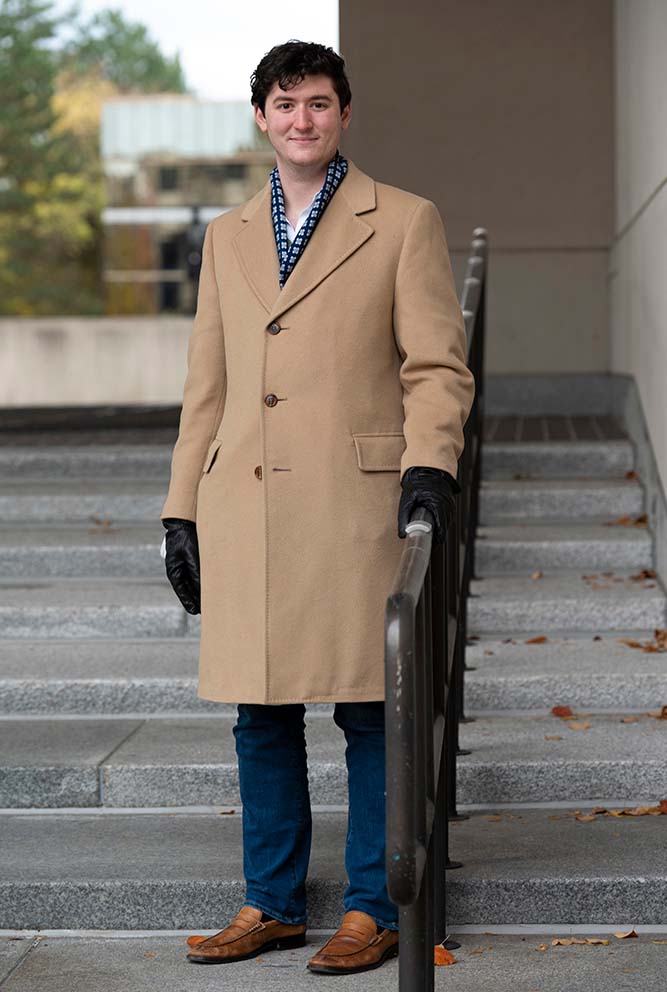 “That’s when my email box and text messages just started blowing up,” recalls Murtazashvili. Afghans needed her help finding their former supervisors — the only people whom applicants could think to approach to verify their employment.
“That’s when my email box and text messages just started blowing up,” recalls Murtazashvili. Afghans needed her help finding their former supervisors — the only people whom applicants could think to approach to verify their employment.
She quickly uncovered some of the manifold challenges of P-2 employment verification: Many of these organizations no longer exist or have merged with other firms. Most organizations didn’t have existing resources for communicating with their former, Afghan employees; or the person who applicants need to find no longer works there. Even with internet access, which many people in Afghanistan don’t regularly have, “It’s hard for people to keep track,” she explains. “So, imagine you’re caught up in this conflict in Afghanistan: How are you going to do this?”
Recognizing an immediate need, Murtazashvili recruited the help of Max Degregorio, a GSPIA graduate student and student research associate at the Center for Governance and Markets (CGM), where Murtazashvili is the founding director. After quickly meeting their two-person team’s capacity, Murtazashvili sent out an email to recruit student volunteers, quickly creating an informal group of about 10, included among them Degregorio (BUS ’19), and GSPIA students Jake Detweiler and Tahmina Ahmed. Then, she tweeted a public call-out, asking people who needed help with P-2 employment verification to email CGM.
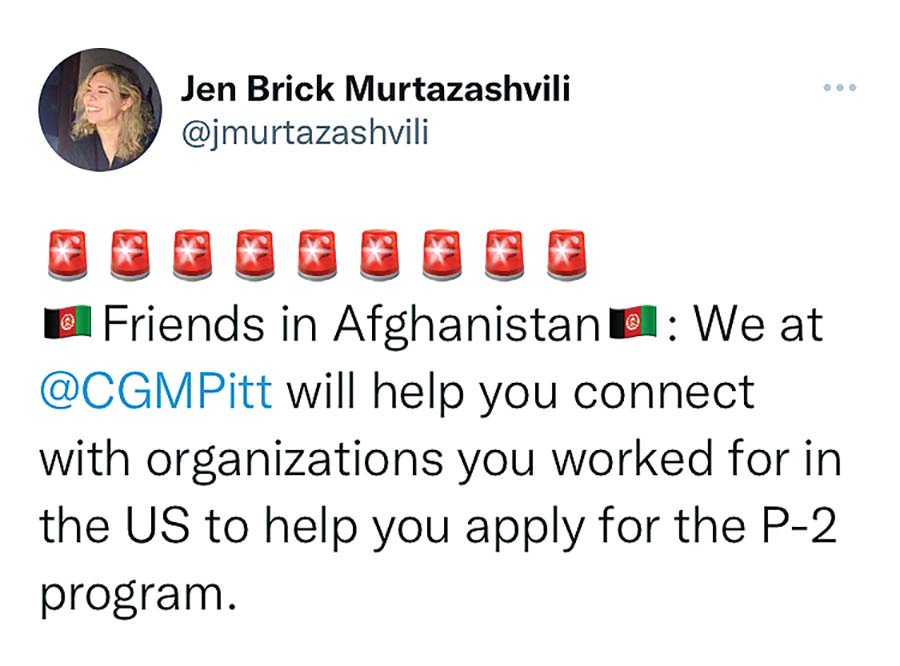
Soon, CGM was helping about 150 Afghan applicants.
Just a week later, Kabul fell to the Taliban. That day, they decided to share her tweet offering P-2 assistance once again.
Within the first 24 hours, CGM’s email, manned by Degregorio, received 700 emails from Afghans pleading for help. More than 1,000 people retweeted Murtazashvili’s offer. And dozens more emails arrived from people at Pitt and around the world offering assistance. Veterans and retirees, undergrads and alumni, homemakers and lawyers. What was once a small team suddenly grew much bigger.
Every Afghan reaching out, says Murtazashvili, would get whatever she and the volunteers could give.
Many of the emails coming to the CGM inbox began politely. “I hope this email finds you well…” But then came their accounts of threats, assault and fear for their lives at the hands of the Taliban. Some, like many of Murtazashvili’s friends, were teachers and researchers at Afghan universities. Many were Afghan employees or family members of those who worked in some capacity for the U.S. military or defense contractors. Some were the Afghan applicants’ relatives living abroad — Canada, Italy, the United States — trying to help family from afar.
In a sense, the student-led group’s roll-up-your-sleeves, can-do approach reflects the question at the core of Murtazashvili’s research, as well as CGM’s focus: How do people — in this case the CGM group — step in to solve problems that are typically considered only at the institutional level, such as the U.S. immigration process? She describes this phenomenon in her research as “bottom-up governance arrangements” or “self-governing solutions.”
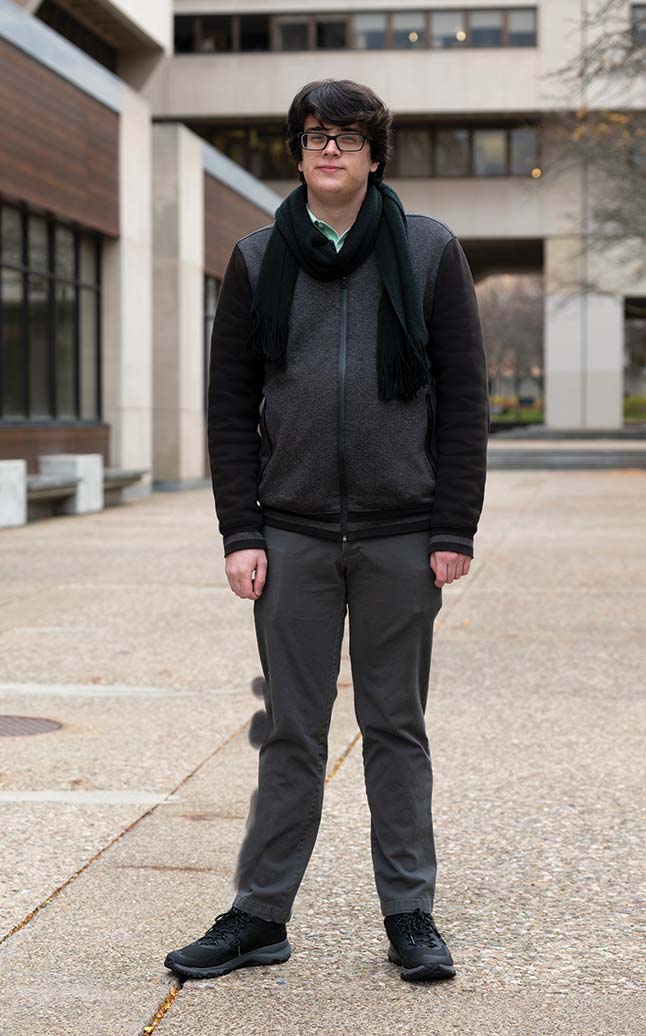 “A lot of this,” Murtazashvili says of CGM, “was inspired by the work that I did in Afghanistan where I’d go around to villages and see how people were solving problems on their own without involvement of the state … how they organize their lives in different and unique ways.” This could be how a village connects to an electrical grid or their means of solving internal conflicts between individuals.
“A lot of this,” Murtazashvili says of CGM, “was inspired by the work that I did in Afghanistan where I’d go around to villages and see how people were solving problems on their own without involvement of the state … how they organize their lives in different and unique ways.” This could be how a village connects to an electrical grid or their means of solving internal conflicts between individuals.
“People have enormous capabilities to do and solve things,” she says, emphasizing that understanding these bottom-up dynamics is crucial for developing successful public policy.
The U.S.’s Afghanistan state-building effort didn’t attempt to fit within this self-governing system, laments Murtazashvili; instead, the Americans tried to start anew and create their vision of what government should look like. So, with the gradual U.S. withdrawal and the Taliban seeing an opportunity to seize power, “people didn’t want to fight for the U.S.-backed government.”
That, Murtazashvili says, is part of why once Taliban fighters entered Kabul in August, they faced almost no resistance. Despite the Taliban’s more-or-less nonviolent arrival, the threat of future retaliation at their hands remained for many, whether they were Murtazashvili’s friends in academia and aid work, or the hundreds of thousands of Afghans who had been employed by and alongside Americans during the past 20 years.
For Detweiler, a 24-year-old grad student who has lived only briefly internationally, reading the Afghans’ emails that combined courteous, business-like deportment with life-threatening urgency was both surreal and revelatory.
“Afghanistan and the U.S. presence there were always in the background for me growing up,” he says. “I had never talked or really thought about Afghanistan intensely until this project,” when it “kind of took center stage in my life.” This was particularly true during the evacuation, the two-week period at the end of August when the GSPIA group assisted international efforts to get as many U.S. citizens, residents and allies out as they could.
To accommodate the drastic influx of asylum seekers, after the fall of Kabul, Detweiler remotely on-boarded dozens more volunteers from Pitt and beyond. From Aug. 15 to Aug. 31, he took calls at night from volunteers working across time zones. Entire days were spent hunting down information on computers and cell phones. Some days he woke up at 4 a.m. to check his email and get up to speed, wondering, “What’s the update on the situation? Are people safe?”
The work done by Detweiler, Degregorio, Ahmed and their peers — to provide and help complete hopeful applicants’ paperwork — was an essential step at the very beginning of an applicant’s journey to asylum in the United States. Only by submitting this paperwork could applicants be put on the State Department’s radar for assistance and in the running for a visa. In the long term, their work also has given many Afghan applicants the hope of becoming a permanent U.S. resident.
In September, the Elsie H. Hillman Foundation, which supports philanthropic and civic work, recognized the benevolent efforts of the Pitt team, now calling themselves the CGM Afghan Asylum Assistance Task Force, and awarded them a $25,000 grant. With these funds, Murtazashvili says, the task force can pay for software that streamlines the application intake process. The grant also provides a modest salary to student volunteers.
So, when the academic year began, they had the resources to sustain their work — what is essentially a nonprofit startup — throughout the semester. “It’s been like building and running an NGO from scratch,” Detweiler says.
The task force’s efforts live in a color-coded master spreadsheet: a list of names, locations, birthdays, job titles, contact information — anything that can help volunteers complete each applicant’s employment verification. “This is what we originally set up and are best equipped to do,” Detweiler says. By the end of August, they had added about 1,500 applicants to their master list, and Detweiler had on boarded 60 volunteers.
Detweiler describes the last two weeks of August as “madness… I don’t think we ever really thought we would be trying to help with evacuations, but that’s the role we sometimes found ourselves in or what applicants desperately needed.”
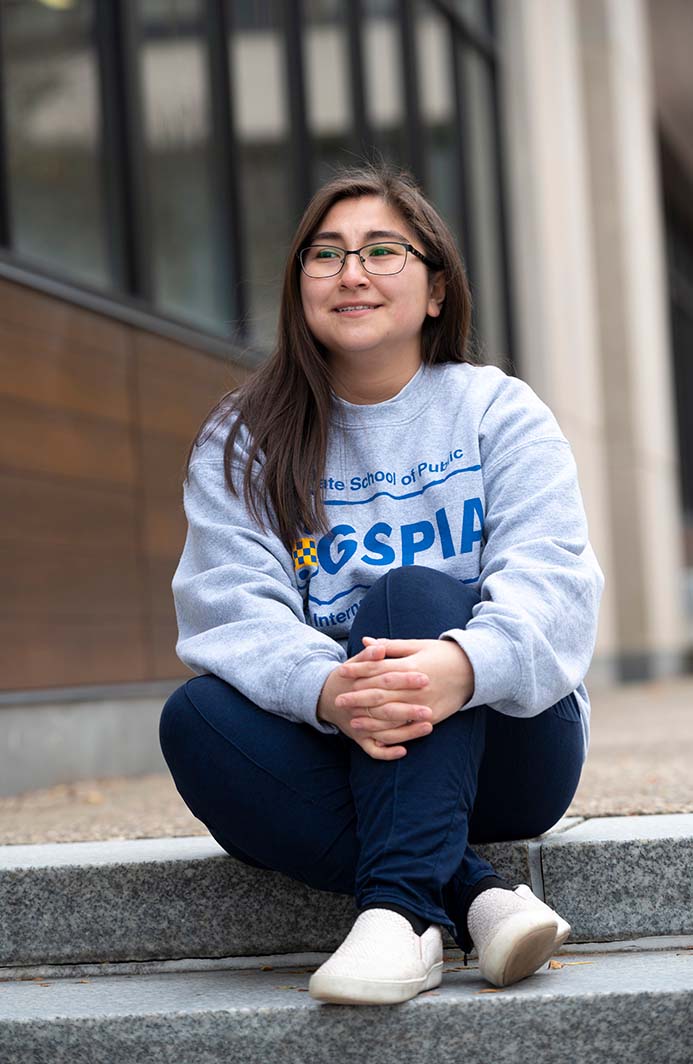 Volunteers overheard gunshots while on the phone as they tried to direct refugees through the Kabul airport; they helped Afghan journalists get seats on the New York Times’ corporate plane; Ahmed, one of the first student volunteers, even helped a member of the Afghan Girls Robotics Team. By working with the State Department and a larger international grassroots network of volunteers, the task force was able to help put some refugees at the highest risk on evacuation manifests.
Volunteers overheard gunshots while on the phone as they tried to direct refugees through the Kabul airport; they helped Afghan journalists get seats on the New York Times’ corporate plane; Ahmed, one of the first student volunteers, even helped a member of the Afghan Girls Robotics Team. By working with the State Department and a larger international grassroots network of volunteers, the task force was able to help put some refugees at the highest risk on evacuation manifests.
Meanwhile, Detweiler says, Murtazashvili and the task force are still trying to help many of Murtazashvili’s Afghan friends and colleagues who were unable to get out — the initial impetus of the task force itself.
With them in mind, Murtazashvili created the Afghanistan Project. Housed in CGM, it’s a research program that enables Afghan scholars in exile to continue their work by bringing them to Pitt. After securing an initial $250,000 anonymous donation, CGM found partners in the International Institute for Education's Scholar Rescue Fund (IIE-SRF) and the Pittsburgh Network for Threatened Scholars (PiNTS), who are providing considerable financial and logistical support in bringing scholars to Pitt. Funding permitted, Murtazashvili hopes to host at least a dozen scholars in exile, creating what she believes will be the premier voice for Afghan scholars and policy researchers in exile.
“Our goal is to have a permanent program here at CGM for as long as they need it to help them come here and continue their work,” Murtazashvili explains. Pitt and Pittsburgh, she says, have what these Afghan scholars and their families need to pick up life where they left off — including a community of scholars like herself and a small, but present, Afghan population. With many social supports, such as immigrant resettlement organizations, and a low cost of living, Pittsburgh was one of 19 cities recommended by the State Department for Afghan resettlement.
The initiative’s first scholar has already arrived.
Omar Sadr, a friend and longtime colleague of Murtazashvili’s, was among the many thousands of Afghans who sought to leave the country.
He was also one of the friends that Murtazashvili and Degregorio began helping before the fall of Kabul. A professor of political science at the American University of Afghanistan in Kabul, he feared retribution by the Taliban and the former Afghan government because of his public political commentary and research on the complexities of building multicultural democracy.
After what he described as a harrowing journey from Kabul, he, his wife and their baby daughter are settling into their new life in Pittsburgh with the help of Ahmed.
As a staff member of PiNTS, which is housed in Pitt’s Global Studies Center, Ahmed’s job is to ease the way for Sadr and his family, as well as other threatened scholars coming to Pitt. Whether it’s understanding the bus system; signing up for health insurance; finding a place to live; or getting used to American supermarkets, Ahmed introduces them to essential aspects of everyday life in Pittsburgh.
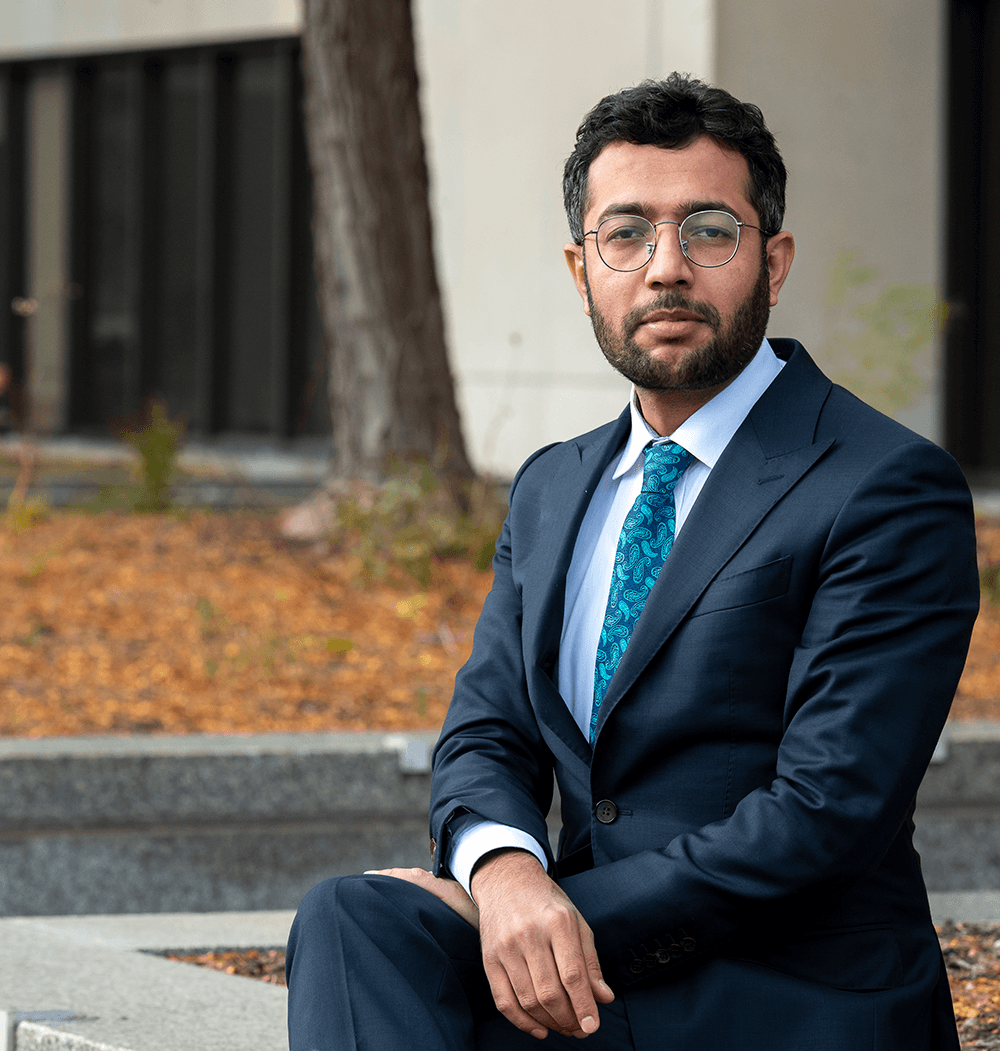 Ahmed has a special understanding of some of what the Sadr family is experiencing. In addition to being a GSPIA student and task force volunteer, she has been trying to help her own relatives who began the visa process but, like so many others, remain stuck in Afghanistan.
Ahmed has a special understanding of some of what the Sadr family is experiencing. In addition to being a GSPIA student and task force volunteer, she has been trying to help her own relatives who began the visa process but, like so many others, remain stuck in Afghanistan.
“It’s heartbreaking at moments,” she says of her conversations with her cousins. “Sometimes they’ll send me videos and pictures of bullets flying in the air, or just airstrikes in the sky, and their kids are just outside laughing” and playing. “But they were born into this mess.”
Sadr and his family are certainly among the more fortunate outcomes. According to the International Rescue Committee, more than 300,000 Afghans have been affiliated with the United States’ state-building efforts in Afghanistan; however, no one knows how many Afghans and their family members are being threatened for these relationships.
So, for Murtazashvili and the task force, the work continues: “Most of my closest friends in Afghanistan have not been able to get out,” she says. “The pain of so many people who have been left behind has really been overwhelming.”
To streamline the employment verification process and hopefully help even more of these asylum seekers, the task force is developing a public, permanent resource of American employees and organizations, as well as their contact information. With a catalog of contacts, Afghan asylum seekers will be able to simply look up the information they need in the student-produced resource.
And that is the goal: to help as many people as possible.
GSPIA Dean Carissa Schively Slotterback notes the breadth of CGM’s impact.
“Jennifer Murtazashvili and the Center on Governance Markets have demonstrated both deep humanity in their work to secure passage for Afghans in the midst of the fall of the Afghan government, and an inspiring vision for the Afghanistan Project — bringing together top Afghan scholars to examine critical governance and policy issues that will shape the future of their country.”
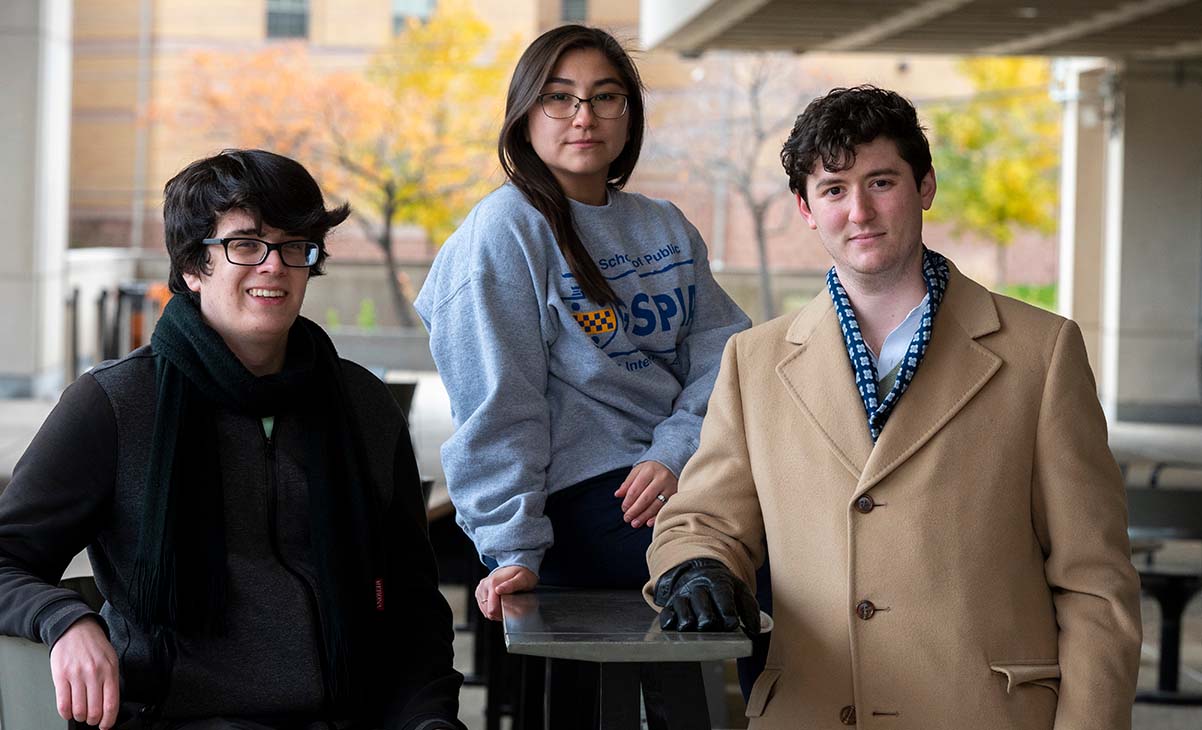 Right now, the task force’s spreadsheet has 4,676 refugees listed; 129 have made it out of the country. Thirty-one names are highlighted in green, meaning they’ve made it to the United States. This is a conservative estimate, Detweiler says; they have no way of knowing for sure who, out of hundreds of active and completed cases, has been able to leave Afghanistan or enter the United States unless they keep in contact with the task force.
Right now, the task force’s spreadsheet has 4,676 refugees listed; 129 have made it out of the country. Thirty-one names are highlighted in green, meaning they’ve made it to the United States. This is a conservative estimate, Detweiler says; they have no way of knowing for sure who, out of hundreds of active and completed cases, has been able to leave Afghanistan or enter the United States unless they keep in contact with the task force.
“Whenever a volunteer gets an email from someone that says they’re in America now,” Degregorio says, “I immediately post it to the group chat. I tag the entire group and I say, ‘They made it! Someone’s out! We did it!’”
The complexity of the situation, however, never escapes them.
“There are very real, human consequences of policy,” Detweiler says. “This is not just an Afghan problem; this is an international problem. Jen is always asking us, ‘How are people — not institutions — solving problems?’”
It goes beyond politics, too. “It’s about preserving community,” Murtazashvili says. “I study how communities support each other from the ground up. Community is everything to me.”
Ultimately, she hopes to see an Afghanistan that embraces peace and freedom. But, until then, she says, “We’ll just keep doing this. I mean, I’ve been working in Afghanistan for two decades; I’m not going to stop now.”
This story was posted on December 9, 2021. It is from Pitt Magazine’s Winter ’21-’22 issue, which will be mailed in January 2022.

